A Guide To Whitewater River Rafting In Colorado
With its stunning landscapes and diverse waterways, Colorado offers an unparalleled playground for both beginners and seasoned rafters alike. In this guide, we’ll jump into the Colorado whitewater rafting scene, explore the allure of its rivers and uncover the best routes for an unforgettable rafting adventure.
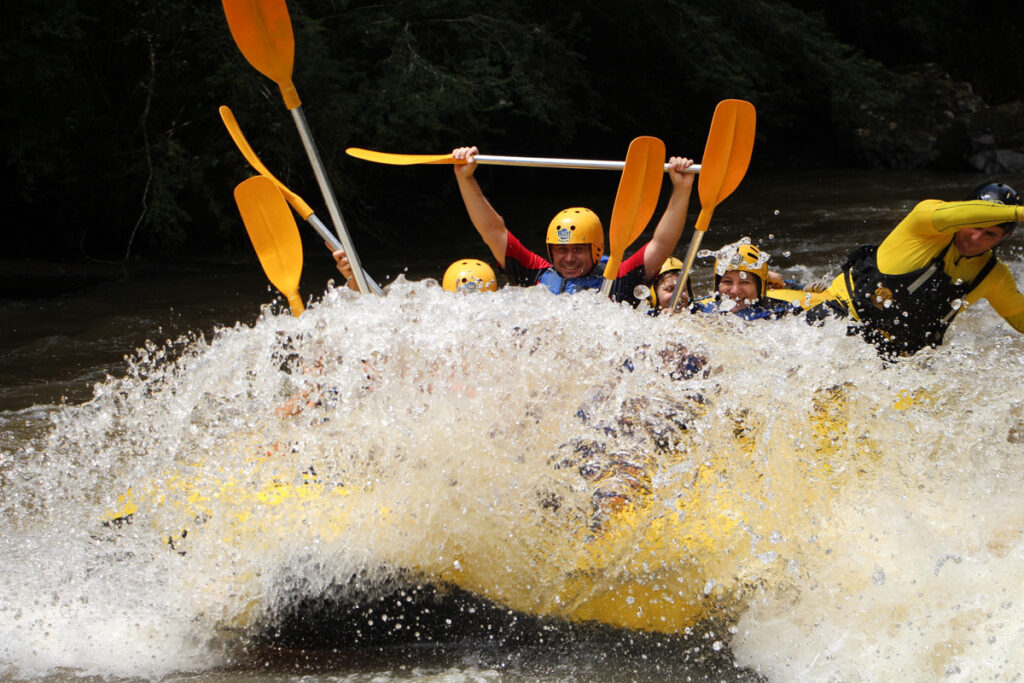
Understanding Class Ratings
Before embarking on any Colorado whitewater rafting adventure, it’s essential to understand the classification system used to categorize rapids based on their difficulty and danger levels. In Colorado, rivers are graded on a scale from Class I to Class V. Each class represents varying degrees of challenge and excitement.
Class I Rapids
These are gentle, beginner-friendly rapids with small waves and minimal obstacles. Class I rapids are ideal for those new to Colorado whitewater rafting or seeking a relaxed, scenic float down the river.
Class II Rapids
Slightly more adventurous than Class I, Class II rapids feature moderate waves and easy-to-navigate channels. Class II rapids provide an enjoyable experience for beginners and families.
Class III Rapids
Intermediate-level rapids characterized by moderately sized waves, swirling currents, and occasional obstacles such as rocks and ledges. These rapids offer an exhilarating challenge for experienced rafters and adventurous novices.
Class IV Rapids
Class IV rapids have powerful waves, turbulent water, and numerous obstacles, including large rocks and tight passages. These rapids demand precise maneuvering and strong paddling skills. Class IV rapids are suitable for experienced rafters seeking an adrenaline-packed adventure.
Class V Rapids
These rapids present extreme challenges with steep drops, violent waves, and treacherous obstacles. They are reserved for the most experienced and skilled rafters. Rafting Class V rapids requires expert navigation, physical endurance, and a thorough understanding of whitewater safety.
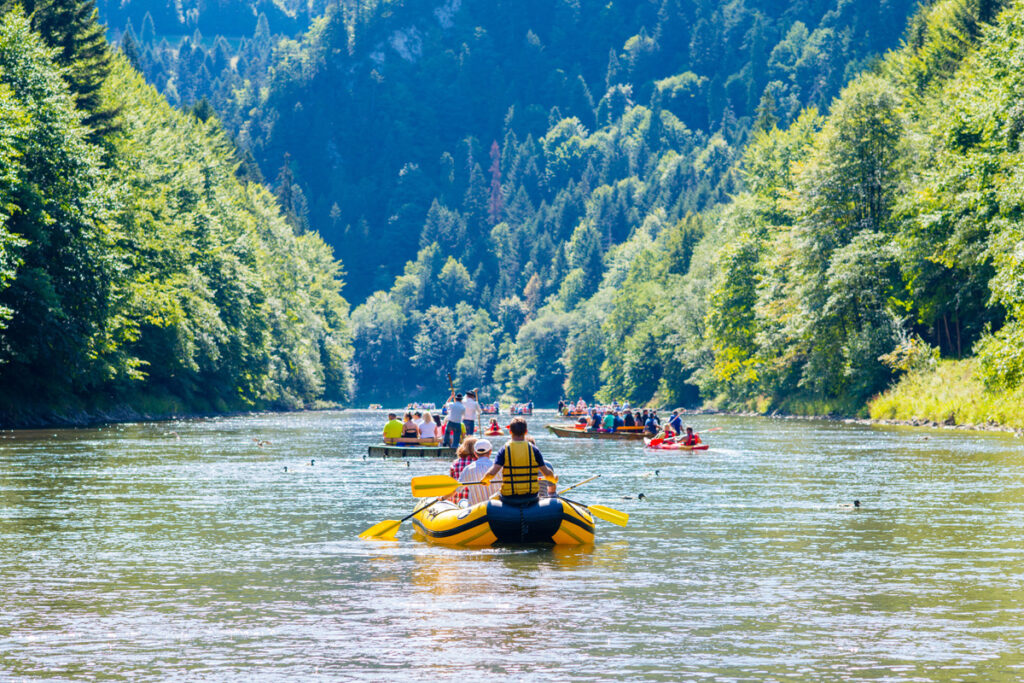
Colorado’s Best Rivers for Rafting
Here are the best rivers in Colorado for a whitewater rafting adventure (in no particular order).
Arkansas River
The Arkansas River is a mecca for whitewater enthusiasts. The river offers a diverse range of rafting experiences across its winding course. There are sections ranging from tranquil stretches perfect for beginners to adrenaline-pumping rapids suited for advanced rafters. Paddle through the breathtaking scenery of Pinnacle Rock, navigate the exhilarating whitewater of Browns Canyon, or brave the towering rapids of Royal Gorge for an unforgettable rafting adventure.
Colorado River
Meandering through rugged canyons and breathtaking landscapes, the Colorado River beckons thrill-seekers to explore its challenging rapids and scenic beauty. From the heart-pounding excitement of Shoshone’s rapids to the adrenaline-fueled journey through the remote wilderness of Gore Canyon, the Colorado River offers a variety of whitewater rafting experiences for adventurers seeking both thrills and tranquility.
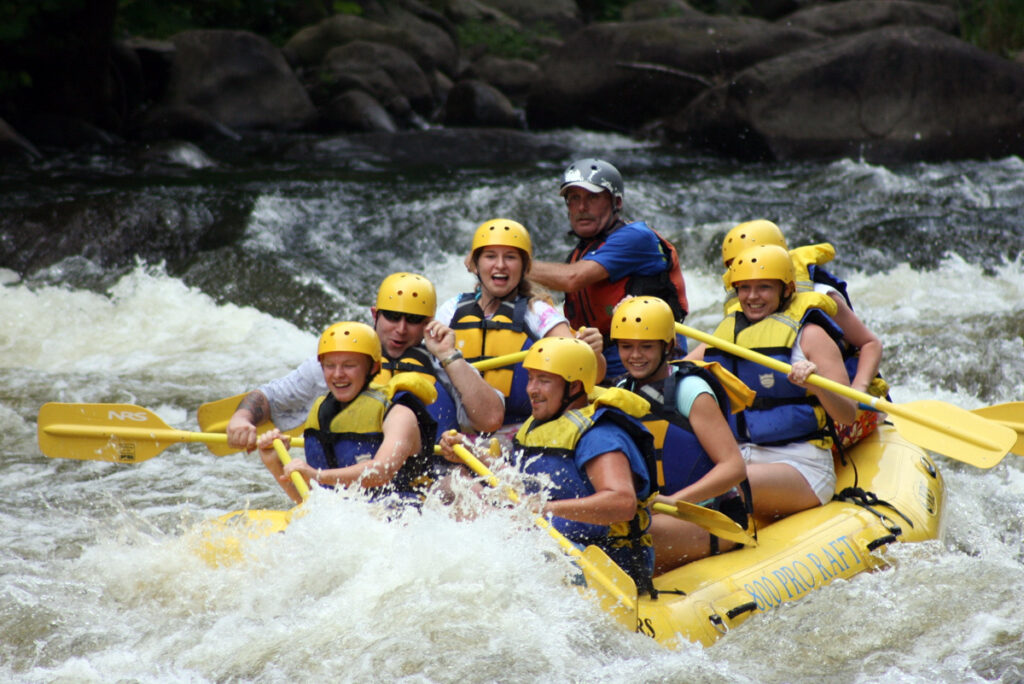
Clear Creek
Clear Creek offers an exhilarating Colorado whitewater rafting experience for adrenaline junkies and nature lovers alike. With sections ranging from the heart-pounding Upper Clear Creek to the more mellow Lower Clear Creek, this river provides an array of options for rafters of all skill levels. Traverse through narrow canyons and soak in the stunning scenery as you embark on a memorable rafting journey. Less than an hour from Denver, it’s perfect for a day trip from the city.
Animas River
Flowing through the charming town of Durango, the Animas River invites adventurers to explore its scenic beauty and challenging rapids. Divided into the Upper and Lower Animas sections, this river offers diverse rafting experiences for both thrill-seekers and families. Brace yourself for the adrenaline rush of the Upper Animas, where steep drops and tumultuous rapids await. Or, opt for a more leisurely float down the Lower Animas, passing through Durango’s historic downtown and the surrounding landscape.
Poudre River
Snaking through the scenic Poudre Canyon, the Poudre River offers an exciting Colorado whitewater rafting experience amidst breathtaking natural beauty. Divided into the Lower and Middle Poudre sections, this river caters to rafters of all skill levels. Experience a thrilling journey through the challenging rapids of the Middle Poudre, where exhilarating whitewater and stunning scenery await at every turn. For a more relaxed outing, explore the serene stretches of the Lower Poudre. This section is ideal for families and those seeking a leisurely float down the river.
Gunnison River
Venture into the rugged wilderness of the Gunnison Gorge and experience the untamed beauty of the Gunnison River. The Gunnison River offers an unparalleled rafting adventure for thrill-seekers and nature enthusiasts alike with its towering cliffs, crystal-clear waters, and challenging rapids. Class III and IV rapids provide an adrenaline-fueled journey through stunning landscapes and remote wilderness.
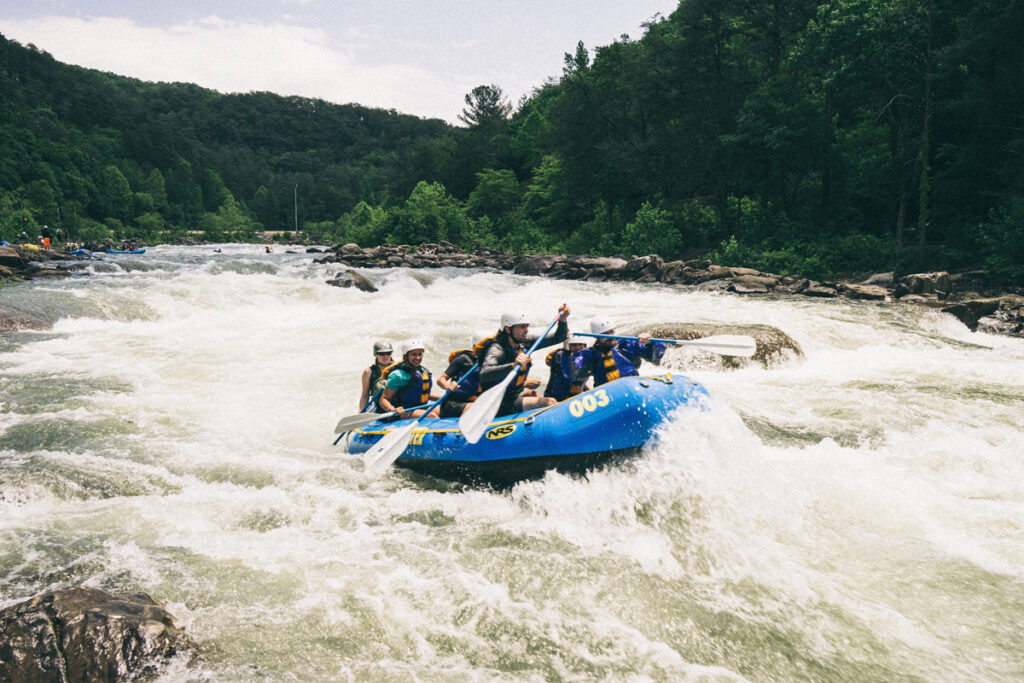
Eagle River
The Eagle River in Vail Valley offers a fun Colorado whitewater rafting experience. Divided into the Upper and Lower Eagle sections, this river provides options for rafters of all levels. Ride the challenging rapids of the Upper Eagle, where adrenaline-pumping whitewater and breathtaking views await at every bend. For a more leisurely outing, explore the scenic stretches of the Lower Eagle. This run is perfect for families and those seeking a relaxed float down the river.
Yampa River
Flowing through rugged canyons and verdant valleys, the Yampa River offers a diverse range of rafting experiences for adventurers seeking both excitement and tranquility. Navigate through the exhilarating rapids of Yampa Canyon, where Class III and IV rapids provide an adrenaline-fueled journey through breathtaking landscapes and remote wilderness.
Dolores River
With its remote location and challenging rapids, the Dolores River offers a truly wild and adventurous rafting experience for seasoned paddlers. You’ll weave through Dolores Canyon, where Class III and IV whitewater provide an adrenaline-pumping adventure amidst breathtaking scenery and untouched wilderness.
San Miguel River
Hidden away in the rugged landscapes of southwestern Colorado, the San Miguel River beckons whitewater rafting adventurers to explore its pristine waters and challenging rapids. Flowing through stunning canyons and dramatic scenery, the San Miguel River offers a distinctive rafting experience. Class III and IV whitewater provide an adrenaline-fueled journey through remote wilderness and rugged terrain.
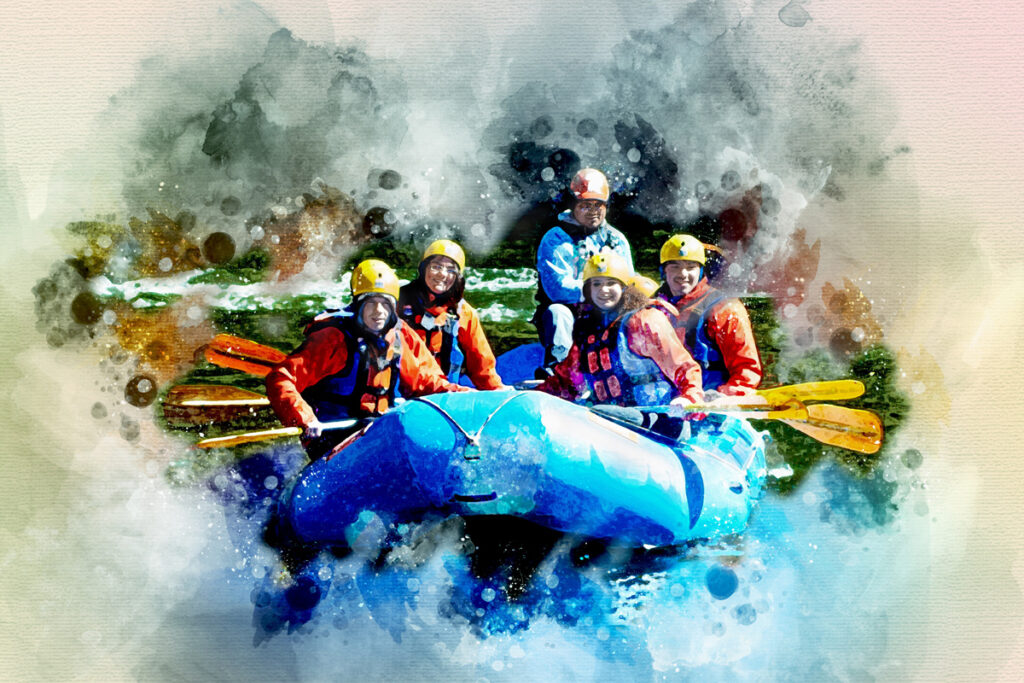
10 Best Rafting Routes in Colorado
Here are our picks for the best Colorado whitewater rafting routes (in no particular order).
1. Browns Canyon on the Arkansas River
- Description: Take in the majesty of Browns Canyon National Monument, where thrilling Class III rapids await amidst stunning granite cliffs and pristine wilderness. This iconic stretch of the Arkansas River offers an exhilarating rafting experience for adventurers of all skill levels.
- Highlights: Enjoy the adrenaline rush of rapids such as Zoom Flume and Widowmaker, soak in breathtaking views of the Collegiate Peaks, and spot wildlife along the riverbanks as you journey through this renowned whitewater playground.
2. Royal Gorge on the Arkansas River
- Description: Brave the towering rapids of Royal Gorge, where the Arkansas River plunges through one of the deepest canyons in Colorado, surrounded by sheer granite walls towering over 1,000 feet high. This exhilarating stretch of river offers adrenaline-pumping Class IV and V rapids for experienced rafters seeking the ultimate Colorado whitewater rafting challenge.
- Highlights: Experience the heart-pounding excitement of rapids like Sunshine Falls and Sledgehammer, marvel at the awe-inspiring beauty of the gorge’s towering cliffs, and feel the rush of conquering one of Colorado’s most iconic whitewater destinations.
3. Gore Canyon on the Colorado River
- Description: Venture into the heart of the Rocky Mountains and navigate the thrilling rapids of Gore Canyon, a remote and rugged stretch of the Colorado River renowned for its challenging Class IV and V whitewater. Surrounded by towering cliffs and pristine wilderness, this adrenaline-fueled journey offers a true test of rafting prowess.
- Highlights: Overcome legendary rapids like Tunnel Falls and Gore Rapid, experience the rush of paddling through steep drops and turbulent waters, and soak in the breathtaking scenery of the canyon’s dramatic landscapes.
4. Shoshone on the Colorado River
- Description: Go on a classic Colorado whitewater rafting adventure on the Shoshone stretch of the Colorado River, located near the town of Glenwood Springs. This exhilarating section of river features continuous Class III rapids, making it perfect for both beginner and intermediate rafters seeking an exciting day on the water.
- Highlights: Enjoy the thrill of navigating rapids such as Baptism, Tombstone, and Maneater. Take in stunning views of the surrounding canyon walls and lush forests. Experience the excitement of paddling through one of Colorado’s most iconic whitewater runs.
5. Clear Creek near Idaho Springs
- Description: Clear Creek offers thrilling Colorado whitewater rafting adventures just a short drive from Denver. With sections ranging from beginner-friendly Class II rapids to adrenaline-pumping Class V runs, Clear Creek provides options for rafters of all skill levels.
- Highlights: Revel in the excitement of rafting through the narrow Clear Creek Canyon. Navigate challenging rapids like Phoenix and Outer Limits. Take in breathtaking views of the Rocky Mountains as you paddle through this scenic waterway.
6. Upper Animas River near Durango
- Description: Known as the “Grand Canyon of Colorado,” the Upper Animas River offers a truly epic whitewater rafting experience through remote wilderness and breathtaking scenery. With challenging Class IV and V rapids, this rugged stretch of river is reserved for experienced rafters seeking an adrenaline-fueled adventure.
- Highlights: Cross legendary rapids like Ten Mile, No Name, and the infamous Class V “Needle’s Eye.” Witness the stunning beauty of the Animas Gorge. Immerse yourself in the thrill of paddling through some of the most challenging whitewater in Colorado.
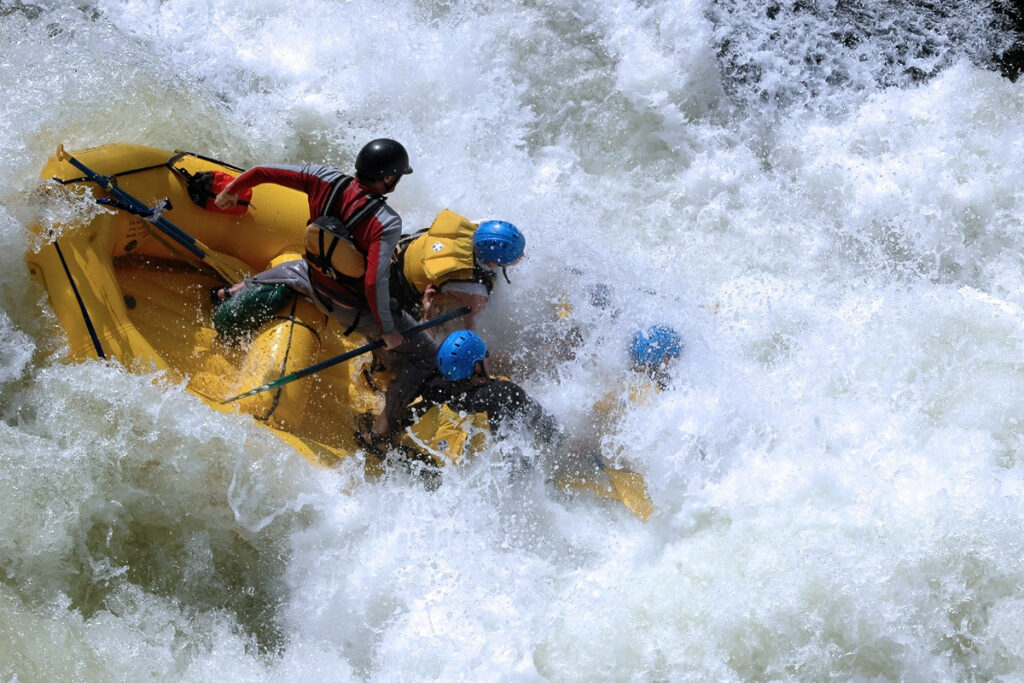
7. Gunnison Gorge on the Gunnison River
- Description: Enjoy an unforgettable Colorado whitewater rafting journey through the breathtaking Gunnison Gorge, a remote wilderness area known for its challenging rapids and stunning scenery. With Class III and IV whitewater, this exhilarating stretch of the Gunnison River offers a true adventure for experienced rafters.
- Highlights: Maneuver through thrilling rapids such as Cable Rapid and the famous Chukar Beach, marvel at the towering cliffs and rugged landscapes of the gorge, and experience the adrenaline rush of paddling through one of Colorado’s most remote and pristine river canyons.
8. Yampa Canyon on the Yampa River
- Description: Unveil the untamed beauty of Yampa Canyon on the Yampa River. The stretch is one of the last free-flowing rivers in the western United States. With challenging Class III and IV rapids, this remote wilderness stretch offers an adrenaline-pumping rafting adventure amidst stunning landscapes and abundant wildlife.
- Highlights: Conquer exciting rapids like Warm Springs and Big Joe. Camp along the riverbanks under starlit skies, and soak in the natural beauty of the canyon’s towering cliffs and lush river valleys on this once-in-a-lifetime expedition through Yampa Canyon.
9. Dolores Canyon on the Dolores River
- Description: Delve into the remote and rugged beauty of Dolores Canyon on the Dolores River, a hidden gem of whitewater adventure in southwestern Colorado. With its challenging Class III and IV rapids, this wilderness stretch offers an unforgettable rafting experience amidst stunning red rock cliffs and pristine desert landscapes.
- Highlights: Navigate through thrilling rapids like Snaggletooth and Razorblade. Marvel at the towering sandstone walls and colorful rock formations of the canyon. Immerse yourself in the solitude and serenity of one of Colorado’s most remote and scenic river canyons.
10. San Miguel Canyon on the San Miguel River
- Description: Go on a thrilling whitewater adventure through the rugged beauty of San Miguel Canyon on the San Miguel River. It’s a hidden treasure tucked away in the rugged landscapes of southwestern Colorado. With its challenging Class III and IV rapids, this remote stretch offers an exhilarating rafting experience.
- Highlights: Crush exciting rapids like Sawpit and the infamous San Miguel Box, soak in the stunning beauty of the canyon’s towering cliffs and lush forests, and experience the thrill of paddling through some of the most challenging rapids in Colorado.
How to Find Rafting Deals
Finding deals on Colorado whitewater rafting adventures can save you valuable money while still enjoying the thrill of the rapids. At Destination Deals, we connect you with the best discounts, deals, and promo codes for rafting experiences across the state. Whether you’re seeking an adrenaline-pumping journey or a leisurely float, our website has unbeatable savings.
Don’t let cost deter you from experiencing the excitement of Colorado whitewater rafting. Visit Destination Deals today and start planning your next (or first) adventure!